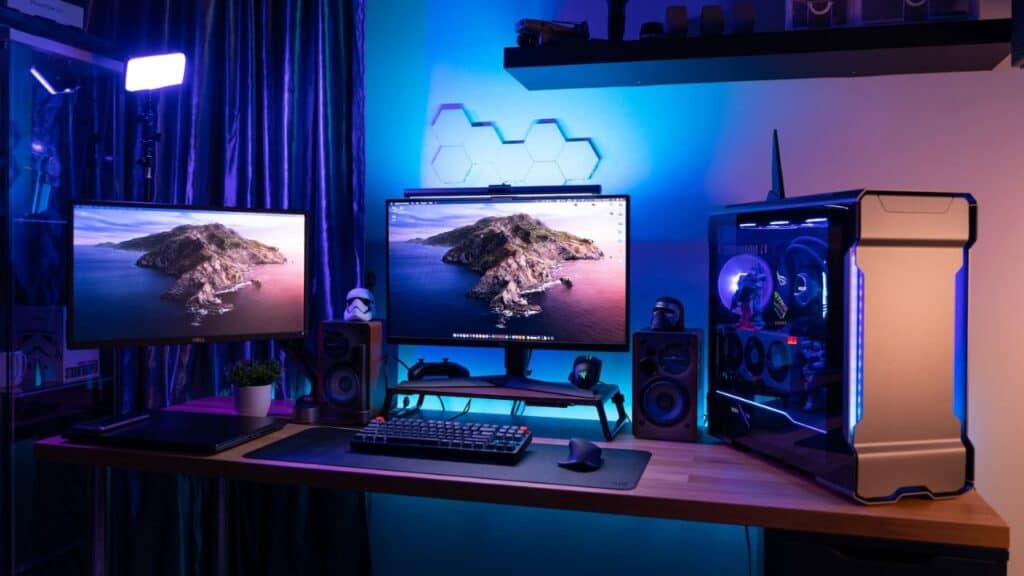GPU prices notwithstanding, it’s a great time to get a gaming PC! Prebuilts might be more convenient, but nothing beats the quality and satisfaction you get when building a custom rig from choice parts. What goes into a gaming PC anyway? What should take priority? Find out in our quick and informative starter guide.

An Optimal CPU & GPU Combo
A processor and graphics card are the core components of a gaming build you’ll likely spend the most on. They determine the level of detail and framerates you can expect. How strong each needs to be depends on the resolution you’re aiming for. If you’re building a new rig and money is no object, you’ll want to invest most of it in a 4K-capable graphics card.
The CPU is less of a consideration at 4K but still important, especially for computationally heavy games, including city builders and 4X titles. While one will always hamper the other to a degree, you’ll want to go for a combination that leaves as few frames as possible on the table.
Software Considerations
A new gaming PC is a blank canvas until you fill it up with your favorite programs and games. It’s best to go with Windows as your OS since most games are developed to run on it. You’ll also need a game launcher like Steam or the Epic Games Launcher. They make buying new games and organizing your digital library a breeze.
You’ll also want a VPN, especially if you’re into online gaming. Other than boosting your online safety and anonymity, a VPN lets you access region-locked games you couldn’t otherwise or start playing new releases hours before they become available in your country. VPNs are great when gaming as they can even sometimes reduce lag if the server the VPN connection routes through is closer to the game server.
However, it’s important to subscribe to a reliable provider that won’t let you down in the middle of your session. Since not all VPNs provide this competitive edge in gaming, it would be wise to check a VPN comparison table to see your options better.
A Good Power Supply
Novice PC builders often mistakenly overlook the power supply or PSU. Yet, it’s a critical component that feeds power to the others. You’ll want to check the PC’s overall wattage requirements and get a model that exceeds them by a fair margin for smooth operation.
The PSU also needs to be certified, preferably 80+ Gold or better. Keep these two tips in mind to avoid unexpected shutdowns or even irreversible damage to your other components.
A Vibrant Monitor or Smart Gaming TV
You can put together the fastest possible rig and still have a sub-par gaming experience if your screen is slow or has washed-out colors. There are far too many displays to choose from, but focusing on a few criteria can make things easier.
Start with the resolution. 1080p is old news, so you’ll want 1440p or 4K, depending on your GPU & CPU budget. Modern monitors generally have a 144Hz refresh rate, which is enough for a buttery smooth experience. Competitive gamers can look at 240Hz and even 360Hz options at 1440p. You don’t lose much visual quality but may gain a competitive edge in that case.
Next is the color gamut, i.e., how many colors the screen shows. Most games use sRGB, so make sure you have 100% coverage. You’ll also want high DCI-P3 and Adobe RGB coverage if you plan to use the display for video editing and color grading.
Smart TVs are gaining traction in the PC gaming world. The smaller ones can still work as desktop monitors, while larger panels let you play games with controller support from your couch. Gaming TVs have exceptionally low response times while benefiting from excellent HDR and OLED panels for stunning contrast. Moreover, if your gaming setup consists of consoles, you can also find VPNs for smart TVs to enhance your online gaming experience.
The Right Peripherals
Split-second decisions win matches, which is why you don’t want to cheap out on your input devices.
Your keyboard should be comfortable and appropriately sized. Tenkeyless is a popular format since gamers rarely need the Numpad, but 60% is also viable if your desk is small. Mechanical keyboards are the most responsive, and gamers tend to prefer Cherry MX Red switches since they’re responsive and relatively quiet.
What mouse to go with depends on which games you play. FPS gamers will want wireless, light rodents with excellent control and minimal click latency. MOBA and MMO players will want alternatives with more buttons.
Don’t neglect the headset, either. Noise-canceling will let you concentrate on the action, even if your younger brother is nagging you to play. A good microphone is essential for clear communication during hectic firefights.
Miscellaneous Stuff
Finally, here are a few words on other components that aren’t as crucial but can refine your gaming experience.
- You don’t need a top-shelf motherboard as long as it has enough connections for all the NVMe drives and RAM you want to add. Better heatsinks and phases are a plus but not crucial if you don’t overclock the CPU.
- An SSD is essential for modern games, but gains to loading times are minimal past PCIe 3.0 speeds
- 32GB of RAM is enough for now. Get more if you edit videos or are into 3D modeling. If you’re on DDR5, investing in anything better than a low-latency 6,000MHz kit brings diminishing returns
- Don’t neglect your case choice. The right case will prevent dust buildup and can either significantly reduce system noise or temperatures